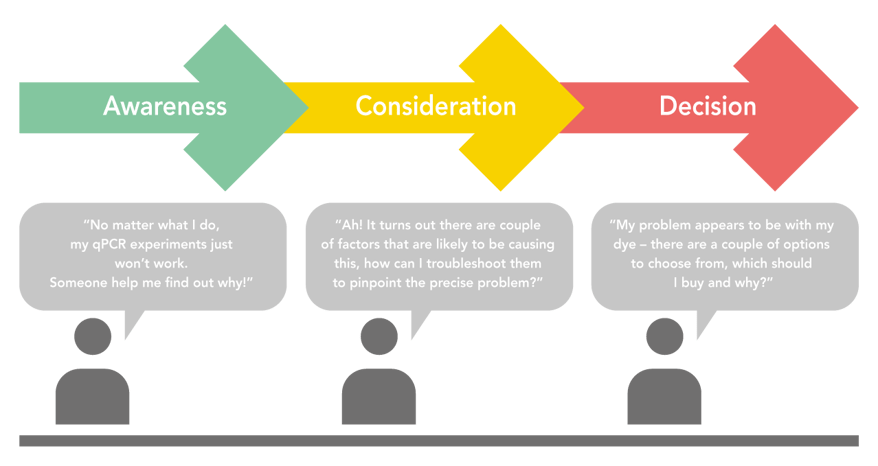As any good marketer knows, goal setting is essential. How else are you going to be able to measure success? But how much thought really goes into your goals, and how are you measuring your performance against them? Well anyone who’s ever had sales training will know that sales goals are highly structured and commonly follow the SMART format – Specific, Measurable, Achievable, Relevant, and Timely. So how can you apply the principles of SMART goals to your marketing strategy to increase the ROI of your campaigns?

Image: Flickr/Paula Naugle/CCBY2.0
Deliver meaningful results using SMART marketing goals
Marketing and sales inherently go hand in hand, with marketing generating leads to pass on to the sales teams. But the volume and quality of leads delivered alone is not the best way to measure success, especially when you take into consideration the full scope of any given campaign (including different buyer persona characteristics and their position within the buyer’s journey). During the planning stages, we would always recommend sitting down as a team to decide on your marketing goals, making them SMART where possible. The first thing to consider is the overall campaign objective – are you trying to raise awareness, generate leads, nurture current leads, a mixture of these or something else entirely? This is important, as the goals you set will help shape the strategy you set, the tactics you implement and how you will look to measure success.
For example, awareness activity cannot be measured by the number of leads passed to the sales team. A SMART goal for such activity could be to “see a 5-fold increase in visitors to your website within one year.”
This is specific (stating a 5-fold increase), measurable (via your website analytics), achievable (a 5-fold increase is not a figure so high that is seems unattainable, especially if you plan to adopt inbound marketing), relevant (one of the first things that someone is likely to do when they learn about your company is visit your website), and timely (you want to see this result in one year).
However a SMART goal for lead generating activity would be quite different. For example, “to increase the number of marketing qualified leads in our database by 500 before the end of the year.”
Again this is specific (stating an increase of 500 marketing qualified leads), measurable (via your CRM or similar system), achievable (the figure is likely to be realistic in the given timeframe), relevant (the action taken by someone as a result of your activity will be to complete a data capture form, and this will allow you to nurture them in the future), and timely (you want to see this result before the end of the year).
Don’t forget your buyer personas
Not all goals are equal and some are more valuable than others. When setting your goals, we recommend that you focus your efforts on the prospects likely to deliver the most value to your business first, before widening your scope. Developing effective buyer personas can help you focus your efforts, identify quick/easy wins and ensure your marketing will deliver the highest possible ROI.
Buyer personas are semi-fictional representations of your different target audiences, and are developed based on real data as well as assumptions. By defining common behaviours and motives, you can predict what action each subset of your audience is likely to take when presented with different marketing materials – allowing you to tailor your marketing messages, creative and content accordingly. Your buyer personas should influence everything you do, from initial goal setting to content development and data capture tactics.
Keep it in context of the buyer’s journey
The other thing to consider throughout the development of your campaign goals and strategy is what stage of the buyer’s journey your prospects are at. If your campaign tactics are targeting buyers at the awareness or consideration stages of the journey, then remember that your audience is only just aware of the problem/need and considering action. You should be creating content that educates and inspires them to overcome a problem, as well as implementing other awareness raising activities that will drive visitors to your website, and encourage them to learn about your company through other means. It’s not that lead capture shouldn’t be a goal, but at this stage it’s probably more important to start ensuring you become a viable, knowledgeable and trusted supplier in the minds of your target audience. You can measure the impact of your efforts by a number of methods e.g. using surveys, tracking your web stats and polling your sales team on any changes in perception they start to observe within the marketplace.
On the other hand, if your tactics are targeting buyer’s late in the journey at the decision stage then they will likely be close to making a choice about which supplier to use. Your goal at this point should be to increase the conversion rate of prospects to customers, for example by creating content that highlights the unique benefits of your solution and building lead nurturing workflows that encourage prospects to take the plunge.
SMART strategy
Goal setting is never an easy task, and getting them right can be a challenge. Not only do they need to be SMART, but you also need to take into consideration your buyer personas and their position in the buyer’s journey. Ideally, you want to select your most valuable buyer personas to begin with, and create a plan that will nurture them through the buying process.
This initial strategic goal setting is worthwhile, since it will enable you to develop a meaningful and relevant report of your marketing results. And we all know that accurately tracking ROI to help direct future decisions is key within any business model.
To learn more about implementing SMART goals within your marketing strategy, get in touch with our team.





